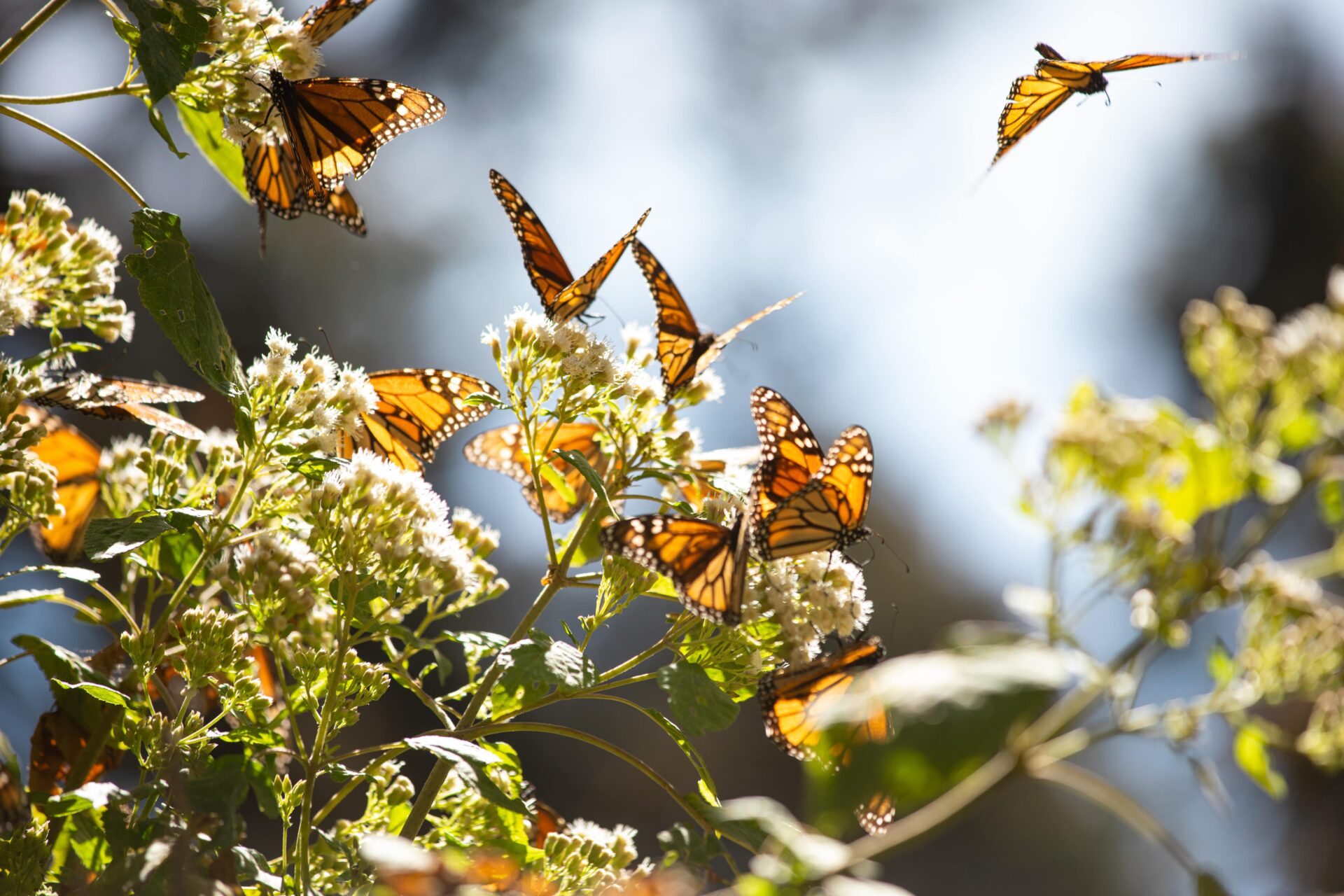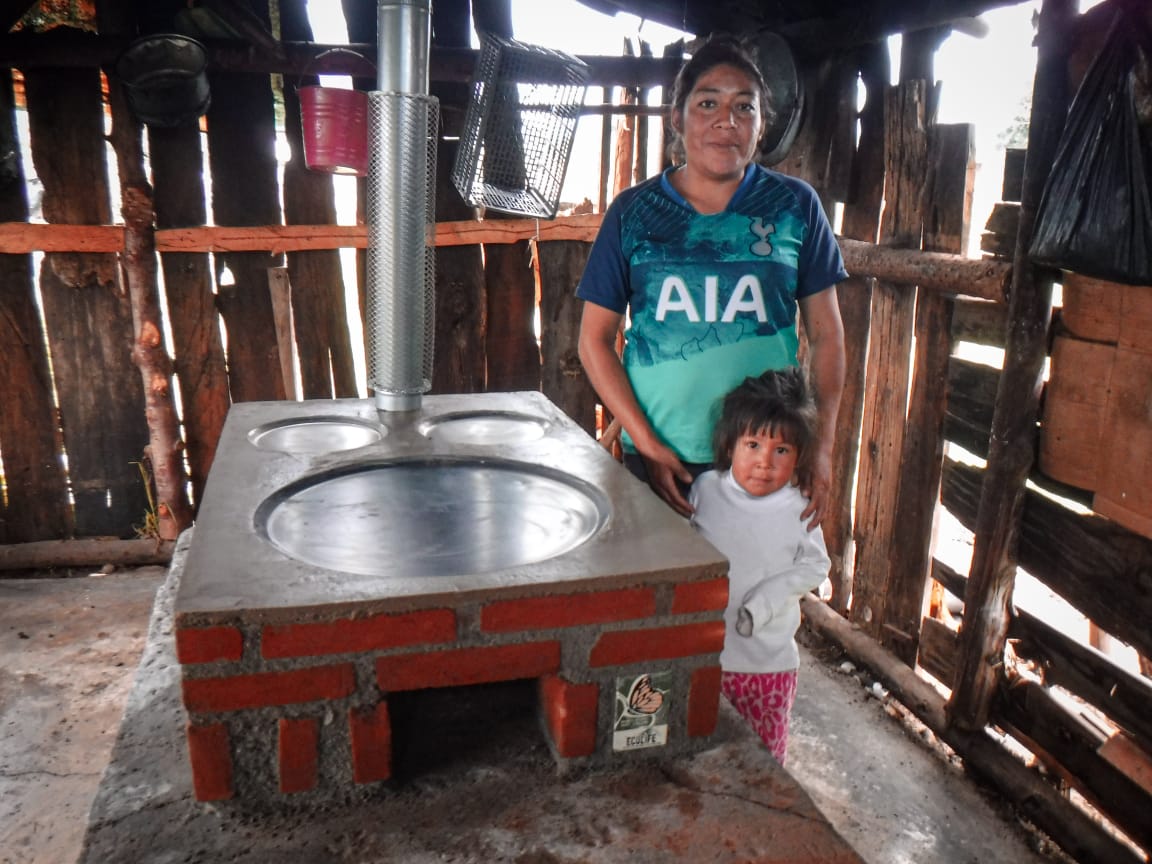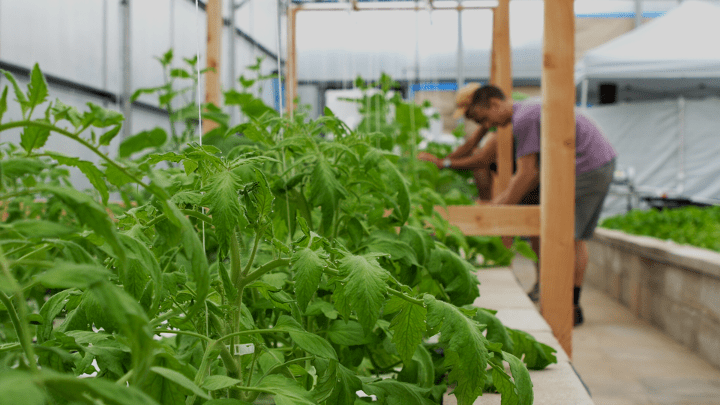Monarch Butterflies and Climate Change: Securing a Sustainable Future

To have a sustainable future, we need to protect our pollinators. This is one of the most important jobs that a monarch butterfly performs. Monarchs pollinate as they make their migration journey, playing an essential role in allowing our ecosystems to thrive. Like bees and other pollinating insects, monarch butterflies also pollinate the flowers that become produce staples.
As the eastern population of monarch butterflies makes their way to central Mexico for their overwintering, they stop and sip on nectar to fuel themselves along their journey. As they eat this nectar, they are dusted by pollen from the flower. As the butterfly moves on to the next flower, the pollen on their bodies is transferred, a process known as pollination.
Monarch butterflies are also a food source for birds, small animals, and other insects. Without monarchs, the food systems (and ecosystems) upon which these animals depend could collapse.
The bottom line is that monarchs help keep our planet healthy and thriving.
The Effect of Climate Change on Monarch Butterflies
The natural world has been profoundly affected by climate change, which is seen most obviously in changing weather patterns, forest fires, and worldwide crop disruptions. This poses a threat to all humans and other forms of life, including monarch butterflies.
Monarch butterflies rely on temperature cues to start their migration, hibernation, and reproduction, making them extremely sensitive to even slight changes. These changing weather patterns will inevitably disrupt critical stages of the monarch butterfly’s migration and life cycle. Unusually warm temperatures at overwintering sites, such as the Monarch Butterfly Biosphere Reserve where we build fuel-efficient stoves, could change or stop monarch butterflies from migrating north in the spring. Colder autumns will also affect when monarchs head south.
In addition, the monarch’s hibernation period is also strongly influenced by temperature. The perfect overwintering site for monarch butterflies is one where temperatures are low enough that the butterflies’ metabolism will not be overly active, but warm enough that the monarchs won’t freeze. Increased and erratic temperatures may reduce the number of monarchs that will be able to survive hibernation.
Increased temperatures also inhibit the growth and quality of milkweed, a plant that is crucial to monarch caterpillars. Less–and lower-quality–milkweed will affect monarch butterflies’ ability to reproduce, as their caterpillars can only feed on this plant.
Increased levels of precipitation also pose a threat to the reproductive activity of monarchs. It’s difficult for monarchs to endure moisture from rainfall in addition to lower temperatures in their overwintering sites, where conditions can’t be too cold without threatening their survival. Bill Toone, ECOLIFE’s founder, witnessed one of the largest monarch die-offs in history as a result of this. Millions of dead butterflies carpeted the forest floors because the air temperatures were too cold for butterfly survival. This is precisely why ECOLIFE works so hard to combat deforestation in the Monarch Butterfly Biosphere Reserve by building stoves that use up to 60% less fuelwood than open-fire cooking.
The consequences of changing weather patterns from climate change and deforestation, in addition to the loss of monarch butterflies’ breeding and hibernation habitat, are seriously impacting the monarch butterfly population. We need to work faster.
How You Can Fight Climate Change & Protect the Monarchs
Understanding the importance of taking action on multiple fronts to save monarch butterflies and ensure a sustainable future, ECOLIFE Conservation created the Patsari stove project and implemented our Sustainable Agriculture Program.
The Patsari Stove Project & Carbon Credits
 The Patsari stove project is not only our culturally-appropriate solution to protecting the Monarch Butterfly Biosphere Reserve but it is also certified to reduce carbon emissions. This means that this program can generate and sell Voluntary Emission Reductions (VER), also known as carbon credits. Carbon credits are an important climate change mitigation mechanism that channels funding into programs that have proven environmental and social benefits. Carbon credits represent an opportunity to help secure a sustainable future while meeting global carbon reduction goals and investing in important emission reduction projects that require funding to take place.
The Patsari stove project is not only our culturally-appropriate solution to protecting the Monarch Butterfly Biosphere Reserve but it is also certified to reduce carbon emissions. This means that this program can generate and sell Voluntary Emission Reductions (VER), also known as carbon credits. Carbon credits are an important climate change mitigation mechanism that channels funding into programs that have proven environmental and social benefits. Carbon credits represent an opportunity to help secure a sustainable future while meeting global carbon reduction goals and investing in important emission reduction projects that require funding to take place.
In Michoacán, Mexico, Patsari stoves improve people’s quality of life while preserving nearby endangered wildlife habitats. Our efforts work to prevent deforestation in the surrounding Monarch Butterfly Biosphere Reserve, where even small-scale tree removal for fuelwood affects the microclimate and the butterflies’ ability to survive storms. With our carbon credit certification, we can protect the overwintering habitat of monarch butterflies while fighting climate change.
Sustainable Agriculture Program – Aquaponics
 Using aquaponics, our Sustainable Agriculture Program is also helping us protect natural resources while providing communities with food.
Using aquaponics, our Sustainable Agriculture Program is also helping us protect natural resources while providing communities with food.
While traditional agriculture is an important part of how we get our food, it often contributes to climate change from land use conversion, heavy machinery, and long supply chains. Further, habitat loss is the main driver of species extinction. Agriculture occupies over 30% of all available land on Earth, affecting countless landscapes upon which species depend.
Aquaponics allows us to grow produce 25% faster using 90% less land and water while eliminating pollution from agricultural runoff. Aquaponics is a sustainable method of food production combining aquaculture (raising aquatic animals) and hydroponics (cultivating plants in water with added nutrients). The synergy between plants, fish, and bacteria in aquaponics is what results in a 90% reduction in the amount of water and land space needed to grow an equivalent amount of produce in conventional soil-based agriculture.
Without having to rely on harmful chemicals and pesticides in agriculture, we can grow safer, healthier food and prevent further deterioration of our lakes, streams, and watersheds. We can safeguard our natural resources and improve community health by providing people with the means to grow nutrient-dense produce while using less land and water. Through the widespread adoption of sustainable agricultural methods like aquaponics, we can feed more people, prevent pollution, and reduce land and water use.
Help Us Secure a Sustainable Future!
Securing a sustainable future starts with creating a sustainable life today. So this summer, we’re asking for your help to keep assisting communities and saving the habitat of monarch butterflies and our vital ecosystems.
Our programs have grown and prospered because of our generous community of supporters. Our team and our beneficiaries are hopeful that we will continue to break our records and have an even bigger impact than we have had before.
Our goal is to raise $300,000 by the end of July. Every dollar helps us continue our work and takes us one step closer to securing a sustainable future. Consider supporting us with a gift today!